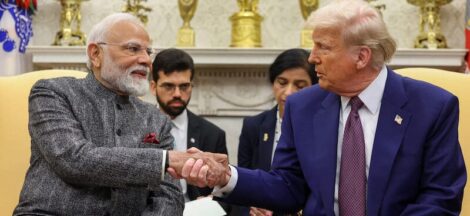By Anjan Roy
India’s stock markets recovered smartly on Tuesday, emerging from the turmoil post Trump tariffs. The unprecedented tariffs declared by Donald Trump had roiled the global financial markets from which the major global centres have yet to recover. On Wednesday till the time of writing, the Indian stock markets had marginal fall taking into account the day before’s bouncing back, but the signs were apparent that the Indian market is no panic mode. There is a feeling of restraint and control.
The sharp rise in the prices of Indian stocks have added close to Rs19 lakh crore to the market value of Indian scrip on Tuesday despite the outflows of funds from foreign institutional investors in Indian equity in the wake of the tariff calls.
The Indian markets recovered by over 2% on Tuesday above the levels when the Trump tariffs were announced and the global markets sank. Against this, the major global markets still remain mired by over 3% from the pre-Trump tariff levels. That makes India the first to recover fully from the turmoil.
This recovery is all the more noticeable as the Indian stock markets had been sliding for the last six months due to slower growth, as well as withdrawal of foreign investors from the Indian markets because of developments in the USA. The foreign investors had withdrawn $16 billion in the last two quarters and this had put pressure on the local markets.
However, since the Trump tariffs were announced, India presented a different story. Although initially the markets had tanked, these recovered quickly as it was realised that India’s exposure to USA was minimal and the performance of the Indian economy was not overly dependent on what happens elsewhere.
Amidst the scene of general collapse, India’s markets have recovered on the strength of its domestic economy. Domestic demand is buoyant and Indian companies hope to cash in on burgeoning demand from the consumers all across the country.
Fundamentally, the investors are banking on the domestic market and India’s stance on handling Trump tariffs. Instead of taking Trump tariffs war head on, India has adopted conciliatory stance and seeking to work out a comprehensive trade deal with the USA. The talks have already begun between the Indian and American trade officials.
So far, so good. The overseas sentiments about India are premised on the hope that India should be a viable alternative manufacturing destination, away from China. Until now, China has been the factory of the world, overwhelming the markets of developed to developing countries with their cheap products. This is what attracted the attention of the western economists and bureaucrats to China’s domestic practices.
Obviously, a single country cannot be more efficient in manufacturing everything from pins to mobile phones. This correspondent had a taste of Cheese domestic practices when he happened to visit some exhibitions in China of their manufacturing prowess. In course of conversations, it was plain that China did not have any concept of costs. Pricing was not in the context of production costs, but what would sell.
Average interest costs of Chinese manufacturers were around 2% and the industrial land did not cost any fortune or involved interminable haggling. It was allotted according to the proposals of the entrepreneurs. More so, if these units were for exports. Hoodwinking the WTO, China would subsidise every product to capture overseas markets.
It is widely maintained by economists that China had exploited the WTO system to push up its exports unfairly at the cost of other countries. Now the time has come for reckoning.
However in the current context of restructuring of the global trade and economies, if India has to emerge as a reasonable alternative sources for supplies and present a new supply chain, it has to develop its domestic manufacturing muscle. There lies the rub.
Despite voluble projection of “Make in India” there has been little progress in that direction. For developing a globally competitive manufacturing base, India needs to undertake some fundamental reforms in developing manufacturing industries on a priority basis.
It is still frightfully difficult to set up a manufacturing unit in the country, land of industrial land being the first major hurdle. Laws will have to be changed to offer industrial land for manufacturing units. Employment laws also have to be suitably changed to suit the requirement of industries of the new age.
Lastly, the laws regarding opening up new areas for basic industries like mining have to be fine tuned. These have proved to be the Achilles’ heels in India in pursuit of developing a large, globally competitive manufacturing base in the country.
The window of opportunity would not last for ever. We would have to hurry up with our programmes for setting up manufacturing base in a diverse range of industries, if we were to emerge as an alternative link in supply chain for the rest of the world. (IPA Service)




 Stalin’s Autonomy Panel Move May Harm The Gains Of Supreme Court Verdict
Stalin’s Autonomy Panel Move May Harm The Gains Of Supreme Court Verdict 